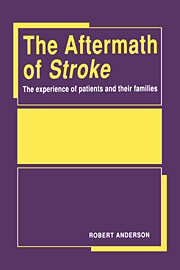Book contents
- Frontmatter
- Contents
- Acknowledgements
- Chapter 1 Stroke: An introduction to the problem
- Chapter 2 The Greenwich stroke study
- Chapter 3 Coming into medical care: the first month after stroke
- Chapter 4 Hospital care and rehabilitation
- Chapter 5 Survival, physical disability and health
- Chapter 6 Support in the community
- Chapter 7 The effects of stroke on social, family and personal life
- Chapter 8 Caring and coping with stroke
- Chapter 9 Resources for coping with stroke
- Appendix: Measurement and scoring of variables
- References
- Index
Chapter 5 - Survival, physical disability and health
Published online by Cambridge University Press: 07 October 2011
- Frontmatter
- Contents
- Acknowledgements
- Chapter 1 Stroke: An introduction to the problem
- Chapter 2 The Greenwich stroke study
- Chapter 3 Coming into medical care: the first month after stroke
- Chapter 4 Hospital care and rehabilitation
- Chapter 5 Survival, physical disability and health
- Chapter 6 Support in the community
- Chapter 7 The effects of stroke on social, family and personal life
- Chapter 8 Caring and coping with stroke
- Chapter 9 Resources for coping with stroke
- Appendix: Measurement and scoring of variables
- References
- Index
Summary
Survival
The literature on survival following stroke (see Chapter 1) indicates strongly that the core group of deaths occur in the first few weeks after the stroke. Nevertheless, there appears to be a relatively high mortality rate throughout the year after stroke, and studies of more disabled samples of patients (Brocklehurst et al., 1978a; Stevens and Ambler, 1982) – as this one is – suggest that perhaps one-third of the patients will die between 1 and 12 months after the stroke. The figures in Table 23 show that altogether 36% of patients died before the end of the first year, and that most of these were deaths before 3 months after the stroke. The proportion of patients who died and, in particular, the proportion who died between 1 and 3 months after the stroke was, as found in other studies, clearly related to the severity of the patient's disability.
Among the various clinical assessments, the absence of normal sitting balance appears to be a particularly strong predictor of early death; 51% of those with abnormal sitting balance died between 1 and 3 months after the stroke, compared with 11% of patients who were able to maintain an upright sitting position. The significance of perceptual and sensory deficits has been identified in recent hospital-based studies (Henley et al., 1985; Fullerton et al., 1986).
- Type
- Chapter
- Information
- The Aftermath of StrokeThe Experience of Patients and their Families, pp. 88 - 113Publisher: Cambridge University PressPrint publication year: 1992



